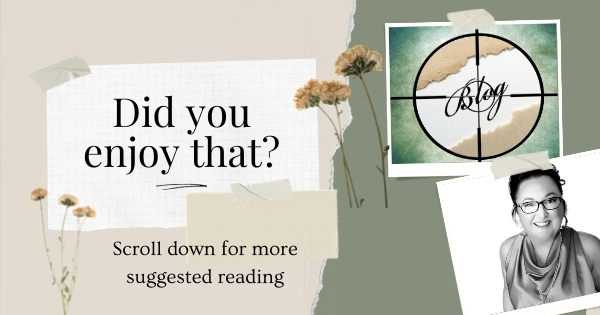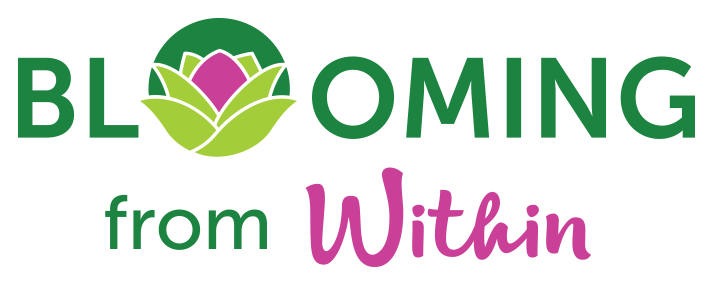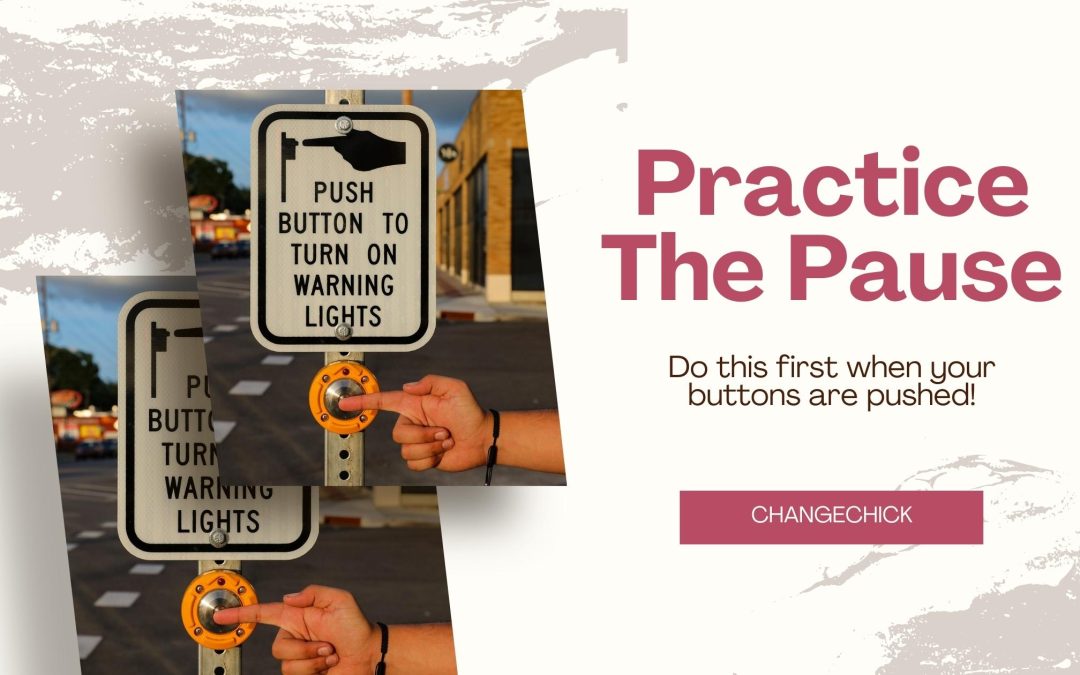First thing to do when your buttons are pushed
Our life is full of experiences. Some are fabulous, some teach us lessons. Some of those lessons just aren’t resolved with a good night’s sleep, and it’s this reaction to the external world that creates our defensive reaction.
Some of those life experiences are hard.
When the lesson hasn’t been fully embraced, we can feel like our buttons have been pushed. What’s happening inside our brain when we experience a triggered reaction is that we don’t quite yet have the resources to work through that situation.
We often repeat the same experience until the lesson is learned. This is often not pleasant and can make life feel hard as we build our resilience muscle.
We are constantly building our emotional intelligence — our capacity to process our emotional response to external life.
If you’re open-minded in relation to change, you can view life as every single experience presents you with a gift to grow and evolve. However, if you’re stuck in your neurological survival reaction, this growth can become stunted. You’re capacity to self-reflect, assess and move forward strategically can become impeded.
When we explore the reactive trigger, there are a whole bunch of things occurring in the brain when it switches into survival mode. As a therapist, explaining our neurobiological response is confusing for most.
Instead, I make reference to the part of our psyche called the inner child — that part of you deep inside that keeps a record of every single experience you’ve ever had, including the feelings you associated with those moments.
This means your inner child carries an emotional wound. It is very much like a garbage can, full of crap thoughts, feelings, and beliefs about yourself and the world. And unless you have emotionally mature and stable parents, your capacity to address all of these emotions generally doesn’t happen until you’re an adult.
By that time, you are consciously aware of when you are triggered because of how it makes you feel. It’s uncomfortable and often leaves you feeling out of control. It’s often the source of your anxiety and panic. It is also something that we avoid until our reactive behaviour feels toxic or gets us into trouble.
When life feels uncomfortable, it’s human nature to want to slam the lid down tight and avoid that discomfort. And yet the more you shove more in, the worse it gets.
It’s like an old septic tank. The more you fill up the vessel, it starts to stink metaphorically. As it gets full, you feel like you want to cry or scream or hit something. You may even want to run from the scenario that drove the trigger.
You can get really worked up. Or rather, your inner child can feel overwhelmed, panicked, anxious, nauseated, and completely out of control. These feelings contribute to the manufacturing of unconscious fears of the unknown, future, and uncertainty.
When those feelings arise, and life feels hard, you should practice the pause.
So the next time when you’re in a situation where the emotional stress feels like it’s getting hot and heavy and not in a good way, pause.
When I explain this to clients, I’m animated and over-exaggerate the emotional feeling so that they can discern this trigger response. I actively try and elicit a bit of a giggle about that when we find ourselves triggered. This demystifies the self-consciousness associated with reactions.
I explain how you can suddenly feel hot, and you feel tight in your chest, it feels like it might explode. The clients nod, “yes, I do that.”
Perhaps you’ve made a fist or are gripping an item when you’re really upset with someone or someplace. More nodding from the client, and their relief is palpable when you can explain what’s happening to them during a moment of overwhelm or panic.
Practising the pause can give you the opportunity of 10 seconds to just take a breath. With a calm, slow deep breath, you can then mentally step out of the situation and acknowledge that whatever is happening in the present moment has activated your survival reaction.
That deep breathing exercise can soothe your vagus nerve and enteric nervous system — your gut. It pacifies the wounded inner child with the conscious action of mindful breathing.
That slow, mindful breath is creating a choice point — do I continue to react, or do I gift myself permission to acknowledge what is my reaction? What am I feeling right now?
And here is where the true gift appears.
Once you are calm, you can:
- acknowledge what you are feeling — heightened, agitated, anxious, fearful, or worried
- continue to breathe mindfully and simply pause the moment to recenter yourself
- remove yourself from the triggering situation (like a conversation) and empty that overflowing emotional garbage can. Bang a pillow on a bed. Scream and yell into a pillow. You need a couple of minutes to defuse that ticking time bomb in your head!
- Return to the conversation (if safe to do so) and attempt to continue the conversation. If there is still a reaction brewing within you, agree to disagree and change the subject or again, walk away.
- Bonus action — you’re allowed to admit that something has triggered you and put another person on notice to tread carefully.
When could this be useful?
So when we’re in a relationship, like someone we live or work with, we are bound to have moments or conversations that activate that trigger response within each other. That’s normal human behaviour.
Allow yourself to be present in any conversation. Active listening to what is being said and how your body responds is such a gift. The more closely you can pay attention to the microsecond your trigger behaviour commences, the sooner your can be proactive and pause the reaction.
When you practice the pause, you’re allowed to tell someone, “that’s kind of pushed my buttons”. Fully own this reaction is yours. It’s your inner child yanking on the hurt chain and feeling uncomfortable.
If mindful breathing doesn’t reduce the discomfort, remove yourself from the situation. Tell the other party, “I’m just going to gift myself five minutes to attend to my stuff, and then I’m going to come back, and we’ll continue this conversation”.
Have an agreement with those you live with to also practice the pause. You can avoid arguments when you own your reaction and remove yourself from tense situations before saying things you can’t retract.
Introducing the ‘pause.’
When introducing ‘practice the pause’ to your home or workplace, or friendship circle, have a conversation when everyone is calm. I made a podcast episode for my clients to listen to with others.
Relationship conversations have an improved chance of success and positive outcomes when you have rules of engagement. You’re allowed to walk away and pay attention to what makes you uncomfortable. You’re also allowed to not invest in another’s drama dance and make someone else’s trigger reaction all about you.
Here’s how you can frame permission for yourself and others —
“So that I have a clear head and can actively listen to what it is you’re saying to me, and I can respond and not react I would like to introduce permission to pause in our conversations.
It starts with breathing in through your nose and extended breath out through your mouth. Count to 10 breathing mindfully. So if you need to do two breaths, because you’re not good at deep breathing, I don’t care what it takes, but breathing and out deeply, slowly, purposefully for a count of ten.
Then ask yourself “what am I feeling right now?” If however, you’re too worked up, this is your permission to walk away and cool down.
Go bang a pillow, stamp your feet or scream! Come find me when you’re feeling better within yourself.
Sit with your hand on your chest and tell yourself, you know what, right now in this moment, I’m okay. It’s okay. I’m safe. There’s no one standing in front of me with a knife. There’s no fire. There’s no blood dripping on the floor.
Breathe and tell yourself “I’m okay”. Allow yourself to feel yourself calming down.
The breathing technique brings you back to the present time frame. The gift of the present time is usually you have calmed yourself and are no longer running your survival reaction. You are now free to explore a deeper understanding of what that reaction was all about.
This particular tool is extremely useful when navigating difficult emotional situations. I add an additional caveat for clients that if when they return to a conversation and continue to feel uncomfortable or triggered, then pause for an hour.
If the topic continues to be triggering, wait 24 hours. If when you return to the conversation, and there are still some feelings, time out for a week and talk it out with a third party, friend, or therapist.
Yep, that can be incredibly frustrating for the other party, but if you’re actively working through trauma, reactivating your survival reaction is counter-productive to your healing journey.
How is the pause beneficial to healing?
The concept of inserting a small circuit breaker into your survival reaction can literally change your neuroplasticity. In other words, every time you pause and acknowledge the reaction, you are pausing your need to survive. This immediately reduces the volume of emotional stress you are storing within your nervous system and body.
When you regularly implement small actions that release the buildup of that emotional charge in your internal garbage can, life starts to smell sweeter again.
When you bang the bed with a pillow or punch a boxing bag, you physically release stored kinetic energy that has an emotional charge. When you have that physical release, you are opening the lid to your garbage bin and letting out all that stinks. This is the energy that makes your inner child uncomfortable.
After the release, when you take those beautiful, slow deep breaths, it’s like your internal cleansing. You’re shrinking down the mental energy of the thoughts and feelings. You are giving yourself permission to just release that energy with your breath. The physical is no longer blocking your flow.
You may like to walk and swing your arms. This allows the body to shift any further deeply buried emotion. It also allows the body to reset. You might want to go for a quick walk which may then be enough for you to return to your conversation.
When you can acknowledge your discomfort, this is a gift. You’re acknowledging what your subconscious self has been hanging onto. You are conveying to your inner child that the adult version of you is now owning the feelings. More importantly, you are signalling to your inner child that you will now activate a change process.
When we own it, we’re building our emotional intelligence.
When we acknowledge, we are gifting our inner child permission to release the emotional wound. This defuses the discomfort.
We’re also building our mental resilience.
We’re building our physical resilience to put ourselves in stressful situations with an ever-increasing capacity to detach when triggered. We are building internal resources to remove ourselves out of stressful situations and detach from the drama.
We really can choose to change and bloom from within with small circuit breakers to our stress reactions.
Conclusion
Our life is full of experiences, some good and some are downright hard. Some days it’s a matter of pausing and acknowledging you’ve been triggered – and there’s something that needs to be addressed in order to move forward.
It’s simply a matter of making a commitment to yourself and gifting yourself permission to make yourself a priority.
You really can choose to change and bloom from within xxx

Want to read more like this?
This is My Roar – signed copies of my first published book can be purchased from this website.
Self Reflection – A little Look Within – click here
8 Hot Tips How To Journal – click here
Can You Risk Not Stepping Up To Mother yourself? – Click here
About Karen
Change Facilitator
Karen Humphries is a Kinesiology Practitioner, Health & Business Coach, LEAP & NES Practitioner, Intuitive Meditation Facilitator, and published author. She is a self-confessed laughaholic. She loves being of service to the world with her humorous and positive approach to life, encouraging people to ‘choose to change and bloom from within.’


